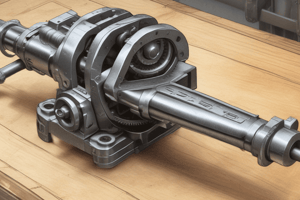Podcast
Questions and Answers
Why is the cutting speed reduced to half of the drilling speed during countersinking?
Why is the cutting speed reduced to half of the drilling speed during countersinking?
- To improve the surface finish and control the conical shape's accuracy. (correct)
- To decrease the risk of work hardening on the conical surface.
- To increase the material removal rate and decrease production time.
- To prevent excessive tool wear due to the increased contact area.
During a tapping operation, what strategies can be employed to mitigate the risk of tap breakage, especially when working with harder materials?
During a tapping operation, what strategies can be employed to mitigate the risk of tap breakage, especially when working with harder materials?
- Increase the cutting speed to prevent chip buildup.
- Use a specialized tap with a geometry designed for the specific material, and apply cutting fluid. (correct)
- Use a dull tap to create a rougher thread profile.
- Apply excessive force to ensure the tap engages the material fully.
What is the primary function of spot facing, and how does it contribute to the integrity of a fastened joint?
What is the primary function of spot facing, and how does it contribute to the integrity of a fastened joint?
- To increase the diameter of the hole for easier bolt insertion.
- To provide a smooth, flat, and perpendicular surface for proper seating of bolt heads or nuts, ensuring even distribution of the clamping force. (correct)
- To harden the surface around the hole, preventing deformation.
- To create a decorative chamfer around the hole's entrance.
A machinist is tasked with selecting a radial drilling that requires both high torque at low speeds for large-diameter drilling and high speeds for small-diameter drilling. Which specification of the radial drilling machine is MOST critical for this selection?
A machinist is tasked with selecting a radial drilling that requires both high torque at low speeds for large-diameter drilling and high speeds for small-diameter drilling. Which specification of the radial drilling machine is MOST critical for this selection?
When reaming a hole, the initial drilled hole should be slightly smaller than the reamer size. What is the MOST important reason for this?
When reaming a hole, the initial drilled hole should be slightly smaller than the reamer size. What is the MOST important reason for this?
In the context of drilling machine operations, which of the following distinguishes counterboring from other hole-enlarging techniques?
In the context of drilling machine operations, which of the following distinguishes counterboring from other hole-enlarging techniques?
A manufacturing engineer is tasked with selecting a drilling machine for a new project involving large, heavy workpieces. Which type of drilling machine would be most appropriate, considering the need for versatility and the size of the components?
A manufacturing engineer is tasked with selecting a drilling machine for a new project involving large, heavy workpieces. Which type of drilling machine would be most appropriate, considering the need for versatility and the size of the components?
During a drilling operation, an anomaly is detected: the hole's surface finish is rougher than required. Considering the subsequent operations available on a drilling machine, which process would be most suitable for refining the hole's surface?
During a drilling operation, an anomaly is detected: the hole's surface finish is rougher than required. Considering the subsequent operations available on a drilling machine, which process would be most suitable for refining the hole's surface?
A machinist observes that the current drilling process, using a particular drill bit, is too slow for enlarging existing holes. Which adjustment to the cutting speed would be most appropriate when switching to a counterboring operation on the same hole?
A machinist observes that the current drilling process, using a particular drill bit, is too slow for enlarging existing holes. Which adjustment to the cutting speed would be most appropriate when switching to a counterboring operation on the same hole?
Which of the following factors is LEAST critical when selecting a bench drilling machine for a workshop?
Which of the following factors is LEAST critical when selecting a bench drilling machine for a workshop?
Flashcards
Reaming
Reaming
Enlarging a drilled hole to a precise size and smooth finish.
Counter sinking
Counter sinking
Creating a conical opening at the end of a hole for countersunk fasteners.
Spot facing
Spot facing
Machining a flat, round surface around a drilled hole for proper seating of bolt heads or nuts.
Tapping
Tapping
Signup and view all the flashcards
Radial Drilling Machine Specs
Radial Drilling Machine Specs
Signup and view all the flashcards
Drilling Machine
Drilling Machine
Signup and view all the flashcards
Bench Drilling Machine
Bench Drilling Machine
Signup and view all the flashcards
Radial Drilling Machine
Radial Drilling Machine
Signup and view all the flashcards
Boring (hole)
Boring (hole)
Signup and view all the flashcards
Study Notes
- Drilling involves using a rotating cutting tool to create circular holes in solid materials.
- The tool used to make the hole is called a drill bit or twist drill.
- A drilling machine is a power-operated machine tool.
- It secures the drill in its spindle.
- The spindle rotates at high speeds.
- When activated, it moves linearly against the workpiece to produce a hole.
Types of Drilling Machines
- Portable drilling machine
- Bench drilling machine
- Radial drilling machine
- Pillar drilling machine
- Gang drilling machine
- Multiple drilling machine
Bench Drilling Machines
- Light-duty machines used in small workshops.
- Also referred to as sensitive drilling machines due to their accurate and well-balanced spindle.
- Performs drilling operation over materials to produce holes with a diameter between 1 mm to 15 mm.
Bench Drilling Machine Parts
- Vertical main column
- Base
- Moving Drill Head
- Work Table
- Electric Motor
- Variable speed gearbox and spindle feed mechanism
Bench Drilling Machine Working
- The workpiece is clamped rigidly on the work table at the exact marked location.
- Align the spindle axis with the center punch indentation.
- Begins by starting the machine and lowering the drill bit by rotating the feed handle.
- The drill bit makes contact with the material and starts the removal process.
Radial Drilling Machines
- Heavy-duty and versatile, designed for drilling large and heavy workpieces.
- Produces holes up to 7.5 cm.
Radial Drilling Machine Parts
- Heavy Base
- Vertical Column
- Horizontal Arm
- Drilling Head
Radial Drilling Machine Working
- Mark the workpiece and properly mount on the work table.
- Position the drill bit precisely by moving the radial arm to the marked location.
- Start the drill spindle motor to commence drilling.
Drilling Machine Operations
- Reaming
- Boring
- Counter boring
- Counter sinking
- Spot facing
- Tapping
Boring
- Increases the size of an already drilled hole using a drilling machine.
- A smaller hole is initially drilled, then a boring tool is used to enlarge the hole.
Counter Boring
- Enlarges the size of a hole at only one end.
- The cutting tool has a small cylindrical portion called a pilot.
- Optimal cutting speed is about two-thirds of the drilling speed for the same hole.
Reaming
- Refers to smoothing the surface of drilled holes with a tool.
- The tool that performs the smoothing is known as a reamer.
- Begin by drilling a hole slightly smaller in size.
- Replaces drill with a reamer.
- Reduces speed to half that of drilling.
Counter Sinking
- Creates a conical shape at the end of a hole
- Optimal cutting speed is half of the drilling speed for the same hole.
Spot Facing
- Creates of a flat, round surface around a drilled hole.
- Prepares proper seating for bolt head or nut.
- Performed using a special spot-facing tool.
Tapping
- Involves cutting internal threads using a thread tool known as tapping
- Operation make use Tap. Tap is a fluted threaded tool employed for cutting internal threads.
- Proceed at a very low cutting speed.
Radial Drilling Machine Specifications
- Power Capacity: Drilling motor 1.5 hp, elevating motor: 0.5 hp.
- Spindle Speed: 50 to 2800 rpm.
- Arm Length: 600 mm, which allows the drill head to traverse.
- Vertical Movement of the Arm: 500 mm
- Angular Swing of Arm: 360°.
- Drill Bit Reach: 350 mm to 900 mm.
- Drill Depth for Steel: 32 mm
Studying That Suits You
Use AI to generate personalized quizzes and flashcards to suit your learning preferences.




